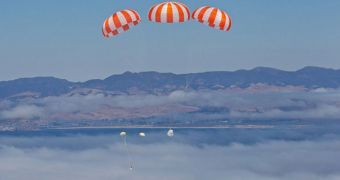A static test fire of the nine engines powering the Falcon 9 medium-lift delivery system that is supposed to take the unmanned Dragon capsule to space on December 7 has failed yesterday, December 3.
Officials at Space Exploration Technologies Corporation (SpaceX), the company that developed both the rocket and the spacecraft, say that engineers will have another go at the 2-second test today.
What's worrying about yesterday's event is that it took place only a few days of the planned launch, which is scheduled to delivery Dragon into low-Earth orbit (LEO) for the first time ever.
According to a press notice, it would appear that the reason why Friday's test was aborted is because one of the Merlin engines on the Falcon 9 experienced a level of chamber pressure above the maximum allowed limits.
“Today the 1st static fire attempt aborted at T-1.1 seconds due to high engine chamber pressure. We are reviewing data now and will make a second attempt tomorrow,” said Kirstin Brost, a SpaceX spokeswoman, quoted by Space.
The Hawthorne, California-based company added that the static test fire was absolutely vital for the coming launch. Falcon 9 is a new rocket itself, having conducted its maiden flight this June.
However, under the terms of the $1.6 billion Commercial Orbital Transportation Services (COTS) program agreement that SpaceX signed with NASA, the corporation needs to launch Dragon this year.
The goal of the flight is to demonstrate the functionality of systems onboard the capsule. It needs to complete at least four orbits around the Earth during its maiden flight, and also to prove that it can respond accurately to commands.
The take-off will take place at the Space Launch Complex 40 facility, which is located at the Cape Canaveral Air Force Station (CCAFS), in Florida.
If successful, the Falcon 9/Dragon combo could be used to conduct at least 12 resupply missions to the International Space Station (ISS) in the coming years.
Officials at SpaceX are also considering improvements to the spacecraft, which will see it customized to allow for the transport of astronauts. Though this objective is some distance away, its implementation will not be tremendously complex.
Dragon has been designed with ferrying astronauts to the ISS in mind since the get-go. All that is needed for this to happen is a conversion of its interior to accommodate life support systems.

 14 DAY TRIAL //
14 DAY TRIAL //